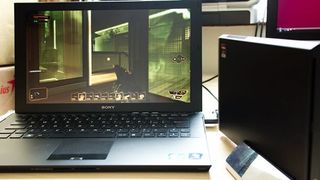Hands on with Sony's external graphics card: it's superb

Over the last week or so I've been playing around with Sony's new Vaio Z laptop. It's not really relevant for a PC games blog - I was looking at it for Stuff magazine - except for one thing. This ultralight notebook comes with an optional dock which adds an optical drive and USB hub along with extra monitor ports for when you're sat at your desk rather than staring at an Excel sheet on the train. Inside that dock, there's an auxiliary graphics card which adds an AMD Radeon HD6650 GPU to the on-board Sandy Bridge processor. And it's stunningly good.
While it's not on a par with a high end desktop - obviously - the HD6650 does have enough graphics power to make Crysis and Deus Ex: Human Revolution playable on the laptop's 1600x900 13 inch screen. That's with graphics options set to medium or above, as well. It'll struggle a bit if you use an external monitor running at 1080p, but on the notebook's screen Crysis framerates are consistently in the mid to high 40s, while DX:HR goes from being a slideshow on the Intel HD 3000 graphics to smooth and sneaky with the dock plugged in.
That's not to say you should rush out and buy a Sony Z series. At almost £2,000/$2,500 for the laptop plus dock you're almost certainly better off with a cheaper thin and light that has NVIDIA Optimus graphics, or a proper gaming laptop like the ASUS G73. However, the astonishing point about the Vaio Z is that the dock connects over USB 3.0. None of your flashy Thunderbolt or Expressport stuff, just a bog standard peripherals port like everything else.
The idea of external graphics, transforming a highly portable PC into a poly-pushing powerhouse, has been around for a long time. ASUS and Dell both had docks in the past which never quite made it market, and Creative was one of the first to talk about modular designs over a decade ago. As far as I'm aware, though, no-one's pulled it off like Sony - and even if the laptop isn't quite as successful as the company hoped (it's up against stiff competition from newer, cheaper 'ultrabooks') I really hope that it develops the dock concept further into something more universal and compatible with other machines.
Because if it does, and can get the price down in future iterations, it'll be quite something for those of us who want a laptop that's both properly portable but doesn't force us to compromise in games.
PC Gamer Newsletter
Sign up to get the best content of the week, and great gaming deals, as picked by the editors.
Most Popular


